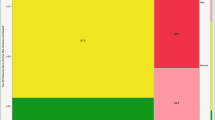Abstract
To examine the effect of breathing pattern on the dose-response curve, 4 mild asthmatic and 9 normal subjects inhaled increasing concentrations of methacholine (0.03–256 mg/ml) using a quiet tidal breathing pattern or tidal breathing with a forced expiratory phase. The provocative concentration of methacholine causing a 20% decrease in the forced expired volume in 1 s (PC20FEV1) or a 200% increase in pulmonary resistance (PC 200RL) was determined. In addition, the maximal change in FEV1 and RL and the slopes of the dose-response curves were measured. The forced expiratory pattern caused an increase in the central/peripheral deposition ratio of a [99m]technetium-labeled aerosol (n=3). There were no differences in mean tidal volume, minute ventilation, inspiratory flow rates, or baseline FEV1 or RL between the quiet breathing or forced expiration studies, although mean expiratory flows were increased in the latter (p<0.001). PC20FEV1 and PC200 RL decreased (p<0.001) but the maximal change in FEV1 and RL was unchanged in the forced expiration studies. Forced expiration during inhalation challenge did not alter the slope of FEV1 or RL dose-response curves. These results suggest that the sensitivity (PC20, PC200) and maximal response of in vivo dose-response curves may be affected independently by factors such as aerosol deposition.
Similar content being viewed by others
References
Armour CL, Lazar NM, Schellenberg RR, Taylor SM, Chan N, Hogg JC, Pare PD (1984) A comparison of in vivo and in vitro human airway reactivity to histamine. Am Rev Respir Dis 129:907–910
Boushey HA, Holtzman MJ, Sheller JR, Nadel JA (1980) Bronchial hyperreactivity. Am Rev Respir Dis 121:389–413.
Brain JD, Valberg PA (1979) Deposition of aerosol in the respiratory tract. Am Rev Respir Dis 120:1325–1373
Cerrina J, Ladurie ML, Labat C, Raffestess B, Bayol A, Brink C (1986) Comparison of human bronchial muscle responses to histamine in vivo and histamine and isoproteranol agonists in vitro. Am Rev Respir Dis 134:51–61
Ding DJ, Martin JG, Macklem PT (1987) Effects of lung volume on maximal methacholine-induced bronchoconstriction in normal humans. J Appl Physiol 62:1324–1330
Dolovich MB, Sanchis J, Rossman C, Newhouse NT (1976) Aerosol penetrance: a sensitive index of peripheral airways obstruction. J Appl Physiol; 40:468–471
Donna E, Danta T, Kim CS, Wanner A (1987) Relationship between deposition of and responsiveness to inhaled methacholine in normals and asthmatics. Am Rev Respir Dis 135:A85
DuBois AB, Botelho SY, Bedell GN, Marshall R, Comroe JH Jr (1956) A rapid plethysmographic method for measuring thoracic gas volume: a comparison with a nitrogen washout for measuring functional residual capacity in normal subjects. J Clin Invest 35:322–326
Hargreave FE, Ryan G, Thomson NC, O’Byrne PM, Latimer K, Juniper EF, Dolovich J (1981) Bronchial responsiveness to histamine or methacholine in asthma. Measurement and clinical significance. J Allergy Clin Immunol 68:347–355
Kirby JG, Juniper EF, Hargreave FE, Zamel N (1986) Total lung capacity does not change during methacholine-stimulated airway narrowing. J Appl Physiol 61:2144–2147
Lippman M (1977) Regional deposition of particles in the human respiratory tract. In: Handbook of physiology, section 9: reactions to environmental agents. American Physiological Society, Bethesda, MD, pp 213–232
Love RG, Muir DCF (1976) Aerosol deposition and airway obstruction. Am Rev Respir Dis 114:891–897
Macklem PT, Fraser RG, Brown WG (1965) Bronchial pressure measurements in emphysema and bronchitis. J Clin Invest 44:897–905
Macklem PT, Mead J (1967) Resistance of central and peripheral airways measured by a retrograde catheter. J Appl Physiol 22:395–401
Macklem PT, Wilson NJ (1965) Measurement of intrabronchial pressure in man. J Appl Physiol 20:653–663
Macklem PT (1985) Bronchial hyporesponsiveness. Chest 87:158S
Mead J, Whittenberger J (1954) Evaluation of airway interruption technique as a method for measuring pulmonary airflow resistance. J Appl Physiol 6:408
Michoud MC, Lelorier J, Amyot R (1981) Factors modulating the interindividual variability of airway responsiveness to histamine. The influence of H1 and H2 receptors. Bull Europ Physiopathol Respir 17:807–821
Moreno RH, Hogg JC, Pare PD (1986) Mechanics of airway narrowing. Am Rev Respir Dis 133:1171–1180
Morris JF, Koski A, Johnson LC (1981) Spirometric standards for healthy nonsmoking adults. Am Rev Respir Dis 103:57–67
Pare PD, Armour C, Taylor S, Mullen B, Moreno R, Hogg JC, Schellenberg RR (1987) Airway hyperreactivity in COPD. Chest 91:40S-44S
Ruffin RE, Dolovich MB, Wolff RK, Newhouse NT (1978) The effects of preferential deposition of histamine in the human airway. Am Rev Respir Dis 117:485–492
Ryan G, Dolovitch MB, Roberts RS, Frith PA, Juniper E, Hargreave FE, Newhouse MT (1981) Standardization of inhalation provocation tests: Two techniques of aerosol generation and inhalation compared. Am Rev Respir Dis 123:195–199
Ryan G, Dolovitch MB, Obminski G, Cockcroft DW, Juniper E, Hargreave FE, Newhouse MT (1981) Standardization of inhalation provocation tests: influence of nebulizer output, particle size, and method of inhalation. J Allergy Clin Immunol 67:156–161
Smaldone GC, Messina MS (1985) Enhancement of particle deposition by flow-limiting segments in humans. J Appl Physiol 59:509–514
Smaldone GC, Messina MS (1985) Flow limitation, cough and patterns of aerosol deposition in humans. J Appl Physiol 59:515–520
Sterk PJ, Daniel EE, Zamel N, Hargreave FE (1985) Limited bronchoconstriction to methacholine using partial flow-volume curves in nonasthmatic subjects. Am Rev Respir Dis 132:272–277
Vincec KS, Black JL, Yan K, Armour CL, Donnelly PD, Woolcock AJ (1983) Comparison of in vivo and in vitro responses to histamine in human airways. Am Rev Respir Dis 128:875–879
Wanner A, Brodman JM, Perez J, Henke KG, Kim CS (1985) Variability of airway responsiveness to histamine aerosol in normal subjects. Am Rev Respir Dis 131:3–7
Woolcock AJ, Salome CM, Dutoit JI, Sundrum R, Black JL (1985) Characteristics of bronchial hyperresponsiveness in smokers. Am Rev Respir Dis 131:A280
Woolcock AJ, Salome CM, Yan K (1984) The shape of the dose-response curve to histamine in asthmatic and normal subjects. Am Rev Respir Dis 130:71–75
Author information
Authors and Affiliations
Rights and permissions
About this article
Cite this article
Guillemi, S., James, A.L. & Pare, P.D. Effect of breathing pattern during inhalation challenge on the shape and position of the dose-response curve. Lung 167, 95–106 (1989). https://doi.org/10.1007/BF02714936
Accepted:
Issue Date:
DOI: https://doi.org/10.1007/BF02714936




